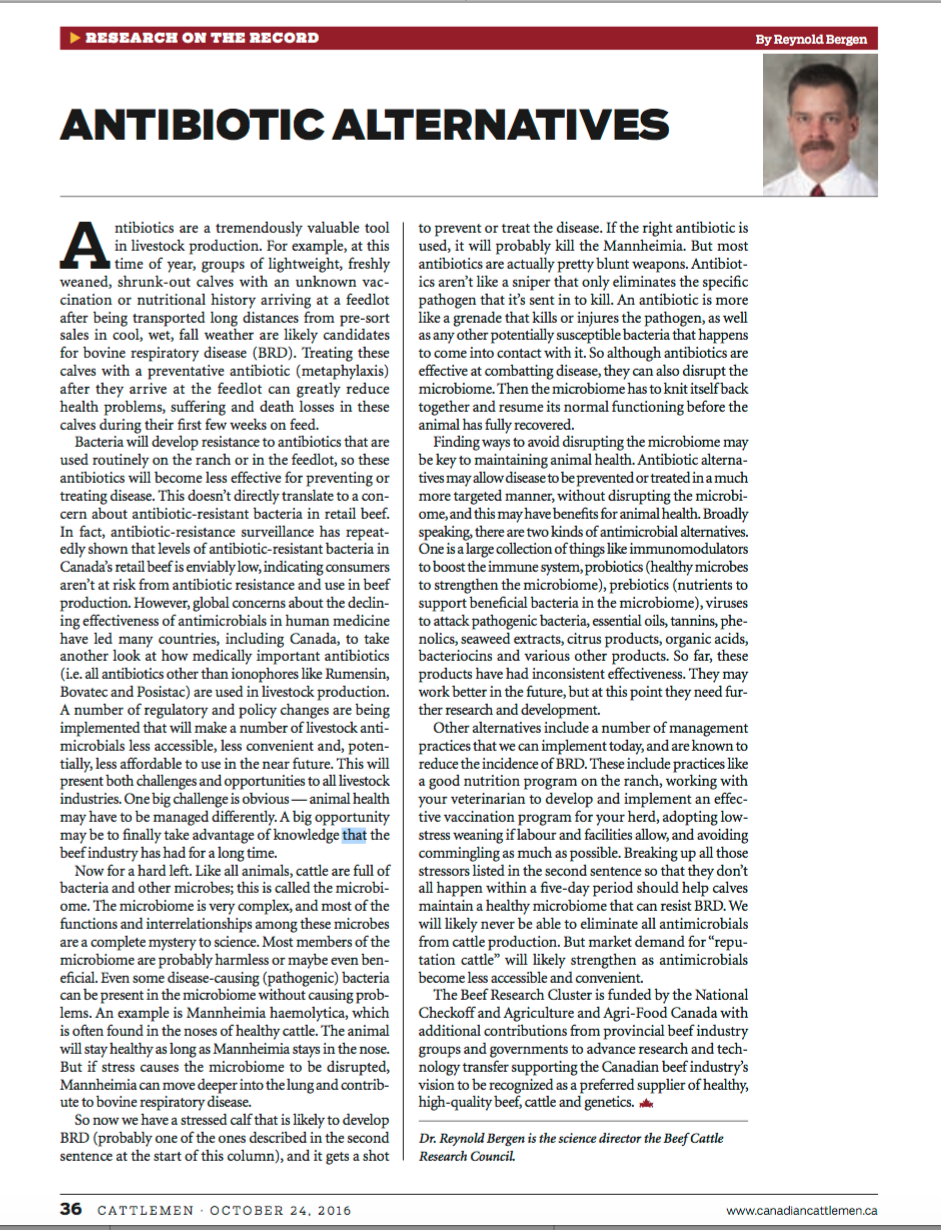Antibiotic Alternatives
This article written by Dr. Reynold Bergen, BCRC Science Director, originally appeared in the October 2016 issue of Canadian Cattlemen magazine and is reprinted on the BCRC Blog with permission of the publisher.
Antibiotics are a tremendously valuable tool in livestock production. For example, at this time of year, groups of light-weight, freshly weaned, shrunk-out calves with an unknown vaccination or nutritional history arriving at a feedlot after being transported long distances from pre-sort sales in cool, wet fall weather are likely candidates for bovine respiratory disease (BRD). Treating these calves with a preventative antibiotic (metaphylaxis) after they arrive at the feedlot can greatly reduce health problems, suffering and death losses in these calves during their first few weeks on feed.
Bacteria will develop resistance to antibiotics that are used routinely on the ranch or in the feedlot, so these antibiotics will become less effective for preventing or treating disease. This doesn’t directly translate to a concern about antibiotic resistant bacteria in retail beef.
In fact, antibiotic resistance surveillance has repeatedly shown that levels of antibiotic resistant bacteria in Canada’s retail beef is enviably low, indicating consumers aren’t at risk from antibiotic resistance and use in beef production. However, global concerns about the declining effectiveness of antimicrobials in human medicine have led many countries, including Canada, to take another look at how medically important antibiotics (i.e. all antibiotics other than ionophores like Rumensin, Bovatec and Posistac) are used in livestock production. A number of regulatory and policy changes are being implemented that will make a number of livestock antimicrobials less accessible, less convenient, and potentially less affordable to use in the near future. This will present both challenges and opportunities to all livestock industries. One big challenge is obvious – animal health may have to be managed differently. A big opportunity may be to finally take advantage of knowledge that the beef industry has had for a long time.
Now for a hard left.
Like all animals, cattle are full of bacteria and other microbes; this is called the microbiome. The microbiome is very complex, and most of the functions and inter-relationships among these microbes are a complete mystery to science. Most members of the microbiome are probably harmless or maybe even beneficial. Even some disease causing (pathogenic) bacteria can be present in the microbiome without causing problems. An example is Mannheimia haemolytica, which is often found in the noses of healthy cattle. The animal will stay healthy as long as Mannheimia stays in the nose. But if stress causes the microbiome to be disrupted, Mannheimia can move deeper into the lung and contribute to bovine respiratory disease.
So now we have a stressed calf that is likely to develop BRD (probably one of the ones described in the second sentence at the start of this column), and it gets a shot to prevent or treat the disease. If the right antibiotic is used, it will probably kill the Mannheimia. But most antibiotics are actually pretty blunt weapons. Antibiotics aren’t like a sniper that only eliminates the specific pathogen that it’s sent in to kill. An antibiotic is more like a grenade that kills or injures the pathogen, as well as any other potentially susceptible bacteria that it happens to come into contact with it. So although antibiotics are effective at combatting disease, they can also disrupt the microbiome. Then the microbiome has to knit itself back together and resume it’s normal functioning before the animal has fully recovered.
Finding ways to avoid disrupting the microbiome may be key to maintaining animal health. Antibiotic alternatives may allow disease to be prevented or treated in a much more targeted manner, without disrupting the microbiome, and this may have benefits for animal health.
Broadly speaking, there are two kinds of antimicrobial alternatives. One is a large collection of things like immunomodulators to boost the immune system, probiotics (healthy microbes to strengthen the microbiome), prebiotics (nutrients to support beneficial bacteria in the microbiome), viruses to attack pathogenic bacteria, essential oils, tannins, phenolics, seaweed extracts, citrus products, organic acids, bacteriocins and various other products. So far, these products have had inconsistent effectiveness. They may work better in the future, but at this point they need further research and development.
Other alternatives include a number of management practices that we can implement today, and are known to reduce the incidence of BRD. These include practices like a good nutrition program on the ranch, working with your veterinarian to develop and implement an effective vaccination program for your herd, adopting low-stress weaning if labor and facilities allow, and avoiding commingling as much as possible.
Breaking up all those stressors listed in the second sentence so that they don’t all happen within a five-day period should help calves maintain a healthy microbiome that can resist BRD. We will likely never be able to eliminate all antimicrobials from cattle production. But market demand for “reputation cattle” will likely strengthen as antimicrobials become less accessible and convenient.
Click here to subscribe to the BCRC Blog and receive email notifications when new content is posted.
The sharing or reprinting of BCRC Blog articles is typically welcome and encouraged, however this article requires permission of the original publisher.
We welcome your questions, comments and suggestions. Contact us directly or generate public discussion by posting your thoughts below.
